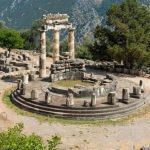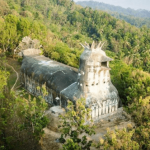 Crime
Crime  Crime
Crime  Technology
Technology 10 Hilariously Over-Engineered Solutions to Simple Problems
 Miscellaneous
Miscellaneous 10 Ironic News Stories Straight out of an Alanis Morissette Song
 Politics
Politics 10 Lesser-Known Far-Right Groups of the 21st Century
 History
History Ten Revealing Facts about Daily Domestic Life in the Old West
 Weird Stuff
Weird Stuff 10 Everyday Products Surprisingly Made by Inmates
 Movies and TV
Movies and TV 10 Actors Dragged out of Retirement for One Key Role
 Creepy
Creepy 10 Lesser-Known Shapeshifter Legends from Around the World
 Animals
Animals 10 Amazing Animal Tales from the Ancient World
 Gaming
Gaming 10 Game Characters Everyone Hated Playing
 Crime
Crime 10 Terrifying Serial Killers from Centuries Ago
 Technology
Technology 10 Hilariously Over-Engineered Solutions to Simple Problems
 Miscellaneous
Miscellaneous 10 Ironic News Stories Straight out of an Alanis Morissette Song
Who's Behind Listverse?

Jamie Frater
Head Editor
Jamie founded Listverse due to an insatiable desire to share fascinating, obscure, and bizarre facts. He has been a guest speaker on numerous national radio and television stations and is a five time published author.
More About Us Politics
Politics 10 Lesser-Known Far-Right Groups of the 21st Century
 History
History Ten Revealing Facts about Daily Domestic Life in the Old West
 Weird Stuff
Weird Stuff 10 Everyday Products Surprisingly Made by Inmates
 Movies and TV
Movies and TV 10 Actors Dragged out of Retirement for One Key Role
 Creepy
Creepy 10 Lesser-Known Shapeshifter Legends from Around the World
 Animals
Animals 10 Amazing Animal Tales from the Ancient World
 Gaming
Gaming 10 Game Characters Everyone Hated Playing
The 10 Deadliest Rituals from Religious History
Religion, throughout human history, has played a key role in shaping cultures and societies. It’s a source of inspiration, comfort, and moral guidance for billions of people. Yet, there’s a darker side to religious practices that often gets overshadowed by peaceful and spiritual aspects.
Join us as we explore the eerie and morbid rituals of religious traditions that have led to death and suffering. From the eerie Voodoo rites to the gruesome Aztec heart extraction, these rituals offer a glimpse into the darker side of human devotion.
Related: 10 Strange Stories From America’s Spiritualist Craze
10 Voodoo Death: When Belief Kills
Voodoo is a religion that emerged from the blending of African spiritual practices and Catholicism in Haiti. It has a reputation for its spells and curses.
Voodoo death is a phenomenon where someone strongly believes that they’ve been cursed and subsequently dies. It’s like the power of suggestion taken to the extreme. The fear and anxiety stemming from this belief can lead to severe stress, triggering a cascade of physiological responses that result in death.
Imagine believing so strongly in the power of a curse that your own belief becomes a death sentence. It’s a testament to the power of the human mind and the depths of faith. This eerie ritual is a stark reminder of how our thoughts and beliefs can shape our reality.
9 Mayan Human Sacrifices: Blood for the Gods
The ancient Maya civilization, known for its impressive architectural and astronomical achievements, also practiced human sacrifice. In their religious ceremonies, they offered human lives to the gods, believing it was necessary to ensure the well-being of their civilization.
Victims, often captives or volunteers, were subjected to brutal rituals that culminated in their death, usually through decapitation or heart extraction. The Maya believed that blood was a source of nourishment for the gods and goddesses, and the sacrifice of a living creature was a powerful offering.
It’s fascinating how advanced and sophisticated the Maya were in many aspects, yet they engaged in such brutal practices. It makes you wonder what drove them to make these sacrifices and whether they genuinely believed it would benefit their society. It may be a reminder that even the most enlightened civilizations can have dark corners.
8 Roman Animal Sacrifice: Rituals of Blood and Fire
In ancient Rome, animal sacrifice was a common religious practice. Romans believed offering animals to the gods would ensure divine favor and protection.
The sacrifices typically involved various animals, such as sheep, goats, or bulls. These animals were an essential part of Roman religious ceremonies and needed to be the best specimen of its kind. It would often be cleaned, dressed in sacrificial garments, and adorned with garland.
While animal sacrifice might not seem as extreme as human sacrifice, it was still a significant part of Roman religious life. It’s like offering a juicy steak to appease the divine but on a grander scale. The sight of blood and fire in these rituals would likely have been fascinating and unsettling.
7 Servant Sacrifice in Egypt: Pharaohs’ Path to the Afterlife
The ancient Egyptians are famous for their intricate burial practices. They believed they needed servants, guards, and even animals in the afterlife to ensure a comfortable journey.
To provide these services, they would kill and bury servants, along with their pharaohs, upon their death. The most common form of death was strangulation, poison, slitting their throats, and being buried alive. This macabre practice saw individuals willingly sacrificing their lives to serve their pharaoh in the afterlife.
It’s a thought-provoking example of devotion and belief in the afterlife. The idea that service continues even beyond death is both haunting and a testament to the power of religious faith. But it also raises ethical questions about the consent of those who were sacrificed.
6 Burning Sons in the Bible: The Story of Child Sacrifice
The Bible is a sacred text for millions. It contains stories that are both inspiring and deeply disturbing. One such story involves child sacrifice.
In the book of Kings, it’s told that King Ahaz offered his sons as burnt offerings. This chilling tale showcases the lengths people were willing to go in the name of faith. In a twisted turn of fate, this act angered God, and in later religions, the valley symbolizes Hell.
It’s like a gripping thriller within a holy book. This story shocks and leaves you pondering the motivations of people willing to make such extreme sacrifices in the name of their beliefs. It’s a stark reminder that religious texts are filled with a diverse range of narratives, not all of which are uplifting.
5 Pharmakos: Scapegoats of Ancient Greece
In ancient Greece, there was a ritual called “Pharmakos.” In pharmakos, a person, often a criminal or an outcast, was chosen as a scapegoat. This person would be paraded through the city, subjected to humiliation and abuse, and then either exiled or killed.
Often, pharmakos was conducted during disasters, famine, invasion, or a plague. The scapegoat was to take on the impurities of the community as a whole. Once exiled or killed, the belief was that this ritual would cleanse the community of its sins and troubles.
Pharmakos is like the ancient equivalent of blaming someone for all your problems and then banishing or punishing them. It reflects the human tendency to look for someone to shoulder the blame and rid ourselves of guilt. It’s a dark ritual that raises questions about the ethics of making one person pay for the perceived sins of an entire community.
4 Celtic Bog Bodies: Sacrifices to the Earth
The Celts were an ancient European civilization. They had a tradition of sacrificing valuable objects and even human lives to the gods and spirits of the land. In some cases, they would deposit these offerings in bogs. These so-called “bog bodies” are remarkably preserved remains of individuals who met a grisly end, often through violent means.
The first bog bodies were found in the 17th century and still pop up from time to time today. While the bog water makes identification impossible, victims were often killed by being strangled, hanged, stabbed, sliced, and hit on the head. These individuals were likely criminals or enslaved people.
The idea of sacrificing something valuable to the Earth is an intriguing one. It’s like burying your most prized possessions in the backyard, believing it will bring you good fortune. These bog bodies are like time capsules, offering a glimpse into the past and the beliefs of our ancestors.
3 Sacrifices to Benin: Blood for a Kingdom
The Kingdom of Benin, located in what is now Nigeria, had a long history of human sacrifice. These rituals often accompanied the coronation of a new king. Victims, usually slaves or prisoners of war, would be sacrificed to ensure the new king’s rule would be prosperous and secure.
It is also thought that many of these sacrifices occurred during the anniversary of the Oba’s reign at an annual bead ceremony. Doing so would please the gods during poor weather that threatened crops or during a health epidemic.
It’s as if becoming a king involved a blood contract with the gods. This practice is a stark reminder of how power and authority have been intertwined with bloodshed throughout history. The sacrifices were seen as necessary for the greater good of the kingdom, but it’s hard not to cringe at the cost.
2 Pathways International Kingdom Restoration Ministries: Recent Dark Chapter in Jamaica
In Montego Bay, Jamaica, a disturbing incident involving a religious sect known as Pathways International Kingdom Restoration Ministries sent shockwaves through the community as recently as October 2023.
Led by a charismatic leader, Kevin Smith, this group is suspected of ritual stabbings and shootings. It is suspected the rituals were conducted to clean impure blood from the victims. When police made contact with the church, there was a shootout with police, which resulted in at least two deaths.
This dark chapter is a chilling reminder that even in modern times, extreme beliefs can lead to unspeakable acts of violence. The influence of charismatic leaders and the power of religious fanaticism can drive people to commit heinous crimes. It is a stark cautionary tale about the dangers of blind devotion, illustrating how radical beliefs can still lead to unthinkable consequences even in the contemporary world.
1 Aztec Heart Extraction: Rituals of Blood and Reverence
The Aztecs, known for their advanced civilization and rich culture, had a dark side to their religious practices. At the heart of their beliefs was the notion that the gods required nourishment in the form of human hearts. This led to gruesome rituals where captives were sacrificed, and their hearts were torn from their chests.
To extract the hearts, priests would use knives, axes, and even long sticks. There are recorded witness testimonies of these rituals happening in ancient Mesoamerican iconography. The one inconsistency is the location on the body where the heart was removed.
Imagine a society where the apex of devotion involved a human sacrifice so gruesome that it’s hard to fathom. It’s like offering up your most prized possession, but in this case, it’s a beating human heart. The Aztec practices are a stark reminder of the lengths people have gone in the name of their gods.








